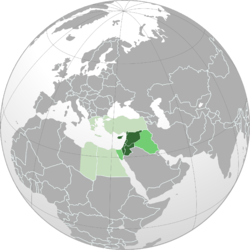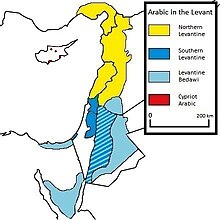Lewant

Lewant takmynan taryhy geografiki adalga bolup, Günbatar Aziýanyň Gündogar Ortaýer deňziniň uly sebitine degişlidir. Häzirki wagtda arheologiýada we beýleki medeni nukdaýnazardan ulanylýan iň dar manyda, Günorta-Günbatar Aziýada Ortaýer deňzi bilen serhetleşýän bir bölege deňdir, [1] [2] ýagny Siriýanyň taryhy sebiti ("has uly Siriýa"), häzirki Siriýa, Liwan, Iordaniýa, Ysraýyl, Palestina we Orta upewfrat derýasynyň günorta-günbataryndaky Türkiýäniň köp bölegini öz içine alýar. Iň esasy häsiýeti, Afrika bilen asewraziýanyň arasyndaky gury köprini görkezýär.[2] Iň giň taryhy manyda Levant, Gündogar Ortaýer deňziniň adalaryny öz içine alýardy; theagny, Gresiýadan Liwiýanyň gündogaryndaky Kirenaika çenli uzap gidýän Gündogar Ortaýer deňziniň kenarýakasyndaky ähli ýurtlary öz içine aldy.
Bu adalga XV asyryň ahyrynda fransuz dilinden iňlis diline girdi. Italýan levante gelip çykýar , gündogarda Günüň dogmagyny aňladýan "çykmak" manysyny berýär, we al-Maşrik adalgasyna ( arap. ٱلْمَشْرِق , [ʔal.maʃ.riq] ), "Günüň çykýan gündogar ýeri" manysyny berýär.
XIII we XIV asyrlarda “ Lewant ” adalgasy Gresiýa, Anadoly, Siriýa-Palestina we Müsür, ýagny Wenesiýanyň gündogaryndaky Gündogar Ortaýer deňzinde italýan deňiz söwdasy üçin ulanylypdyr. Netijede bu söz Siriýa-Palestina we Müsür musulman ýurtlary bilen çäklendirildi. 1581-nji ýylda Angliýa Osman imperiýasy bilen söwdany monopoliýa etmek üçin “ Levant” kompaniýasyny döretdi. “ Levant States ” ady I Jahan Urşundan soň Fransiýanyň Siriýa we Liwan baradaky mandatyna degişlidir. " Lewant " adalgasynyň häzirki Siriýa, Liwan, Palestina, Ysraýyl, Iordaniýa we Kipre degişlilikde has köp ulanylmagynyň sebäbi bolsa gerek. Käbir alymlar munuň Liwanyň adyndan gelip çykýandygyna ýalňyş ynanýarlar. Häzirki wagtda bu termin köplenç taryhdan öňki ýa-da gadymy taryhy salgylanmalar bilen bilelikde ulanylýar. "Siriýa-Palestina" ýa-da Aş- ( arap. ٱلشَّام ٱلشَّام ) ýaly manylary berýär , /ʔaʃ.ʃaːm/ ), demirgazykda Türkiýäniň Toros daglary, günbatarda Ortaýer deňzi, gündogarda demirgazyk Arap çöli we Mesopotamiýa we günortada Sinaý bilen araçäkleşýän sebit goşuldy ýa-da ýok). [3] [2] Adatça, ol Anadoly (Kiçi Aziýa diýlip hem atlandyrylýar), Kawkaz daglary ýa-da Arap ýarym adasynyň haýsydyr bir bölegini öz içine almaýar. Silisiýa (Kiçi Aziýada) we Sinaý ýarym adasy (Aziýa Müsüri) käwagtlar goşulýar.
Häzirki zaman sebitiniň ady hökmünde birnäçe sözlük häzirki wagtda Lewanty gadymy hasaplaýar. [4] [5] [6] “Levantine” aty hem, “ Levantine ” sypaty indi gadymy we häzirki zaman medeni sebitini suratlandyrmak üçin ulanylýar, ozal Siriýa-Palestina ýa-da Bibliýa diýlip atlandyrylýar: arheologlar indi “ Lewant ” we “ Levantine” arheologiýasy hakda gürleýärler; [7] [8] [9] iýmit alymlary Lewantin aşhanasy hakda aýdýarlar; [1] we Lewanyň latyn hristianlary Lewantin hristianlary diýlip atlandyrylmagyny dowam etdirýärler. [10]
“Lewant” “ günbatar Aziýanyň, gündogar Ortaýer deňziniň we demirgazyk- gündogar Afrikanyň çatrygy”, [11] we geologiki ( tektoniki ) manyda “ Arap plastinkasynyň demirgazyk-günbatary” hökmünde häsiýetlendirildi. [12] Lewantyň ilaty diňe bir geografiki ýagdaýy däl, aşhanasy, käbir däp-dessurlary we taryhy bilen paýlaşýar. Olara köplenç “ Levantines ” diýilýär. [13]


Salgylar
[düzet | çeşmäni düzet]- ↑ 1.0 1.1 Gasiorowski, Mark (2016). The Government and Politics of the Middle East and North Africa. {p. 5: "... today the term Levantine can describe shared cultural products, such as Levantine cuisine or Levantine archaeology". ISBN: 081334994X.
- ↑ 2.0 2.1 2.2 Steiner & Killebrew, p. 9: "The general limits ..., as defined here, begin at the Plain of 'Amuq in the north and extend south until the Wâdī al-Arish, along the northern coast of Sinai. ... The western coastline and the eastern deserts set the boundaries for the Levant ... The Euphrates and the area around Jebel el-Bishrī mark the eastern boundary of the northern Levant, as does the Syrian Desert beyond the Anti-Lebanon range's eastern hinterland and Mount Hermon. This boundary continues south in the form of the highlands and eastern desert regions of Transjordan."
- ↑ Steiner & Killebrew, p. 2.
- ↑ LEVANT archaic The eastern part of the Mediterranean with the islands and neighbouring countries. New Oxford Dictionary of English, 2nd ed., revised, 2005.
- ↑ LEVANT, THE. A general term formerly given to the E shores of the Mediterranean Sea from W Greece to Egypt. The Penguin Encyclopedia, revised 2nd ed., 2004.
- ↑ LEVANT, (vieilli) Le Levant: les pays, les régions qui sont au levant (par rapport à la France) et spécialt. les régions de la Méditerrranée orientale. Le Nouveau Petit Robert de la langue française, (1993 revised ed.).
- ↑ Thomas Evan Levy, Historical Biblical Archaeology and the Future: The New Pragmatism, Routledge, 2016 ISBN: 1134937466. Thomas E. Levy, "The New Pragmatism", p. 8: "after 1994, it is possible to see an increase in the use of the less geographically specific and more political [sic] neutral words 'Levant' or 'Levantine' in scholarly citations.... It is important to highlight the pedigree of the term 'Syro-Palestinian' and its gradual replacement by the term 'Levant' or 'Levantine' because the latter is a more culturally and politically neutral term that more accurately reflects the tapestry of countries and peoples of the region, without assuming directionality of cultural influence.". Aaron A. Burke, "The Archaeology of the Levant in North America: The Transformation of Biblical and Syro-Palestinian Archaeology" p. 82ff: "A number of factors account for the gradual emergence during the past two decades of what is now widely identified as Levantine archaeology in North America... a growing consensus regarding the appropriate terminology... archaeological field research in the Levant"
- ↑ William G. Dever, The Lives of Ordinary People in Ancient Israel: When Archaeology and the Bible Intersect, 2012, ISBN: 0802867014, p. 249: "Today, however, the discipline is often called Palestinian, Syro-Palestinian, or Levantine archaeology."
- ↑ Steiner & Killebrew (2013). p. 1-2.
- ↑ Michel Elias Andraos, "Levantine Catholic Communities in the Diaspora at the Intersection of Many Identities and Worlds", in Michael L. Budde, Scattered and Gathered: Catholics in Diaspora, 2017 ISBN: 1532607091 p. 24: "The word 'Levantine' in the title is used on purpose instead of the 'Middle East' or the 'Near East'.... I use 'Levantine' more than the two other designations, because this is the term being used more often nowadays by Christian communities in the Middle East to describe their shared identity as al-maseeheyoun al-mashriqeyoun, Levantine Christians"
- ↑ The Ancient Levant, UCL Institute of Archaeology, May 2008
- ↑ Egyptian Journal of Geology - Volume 42, Issue 1 - Page 263, 1998
- ↑ Orfalea, Gregory (2006). The Arab Americans: A History. Olive Branch Press. Northampton, MA. Page 249.
